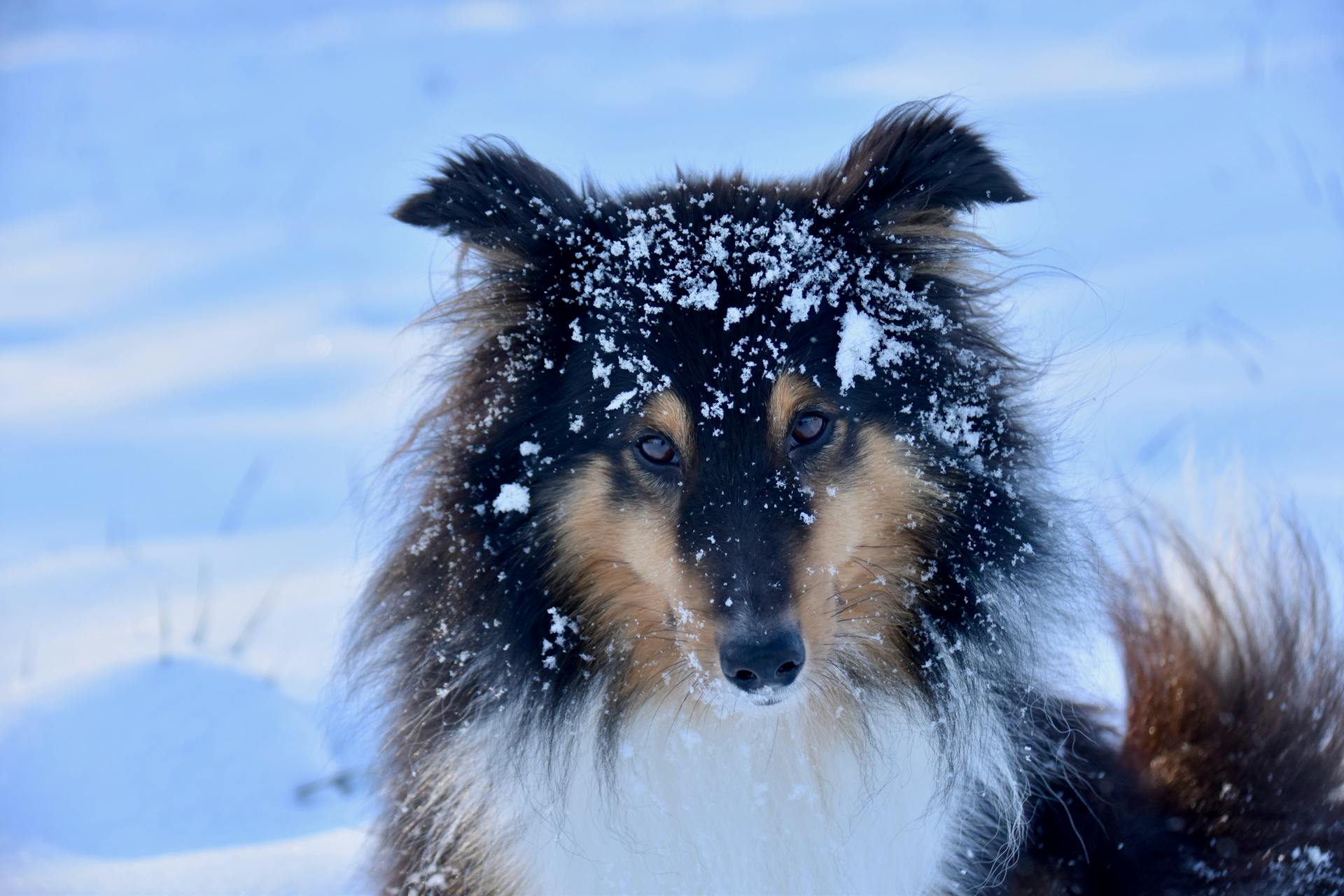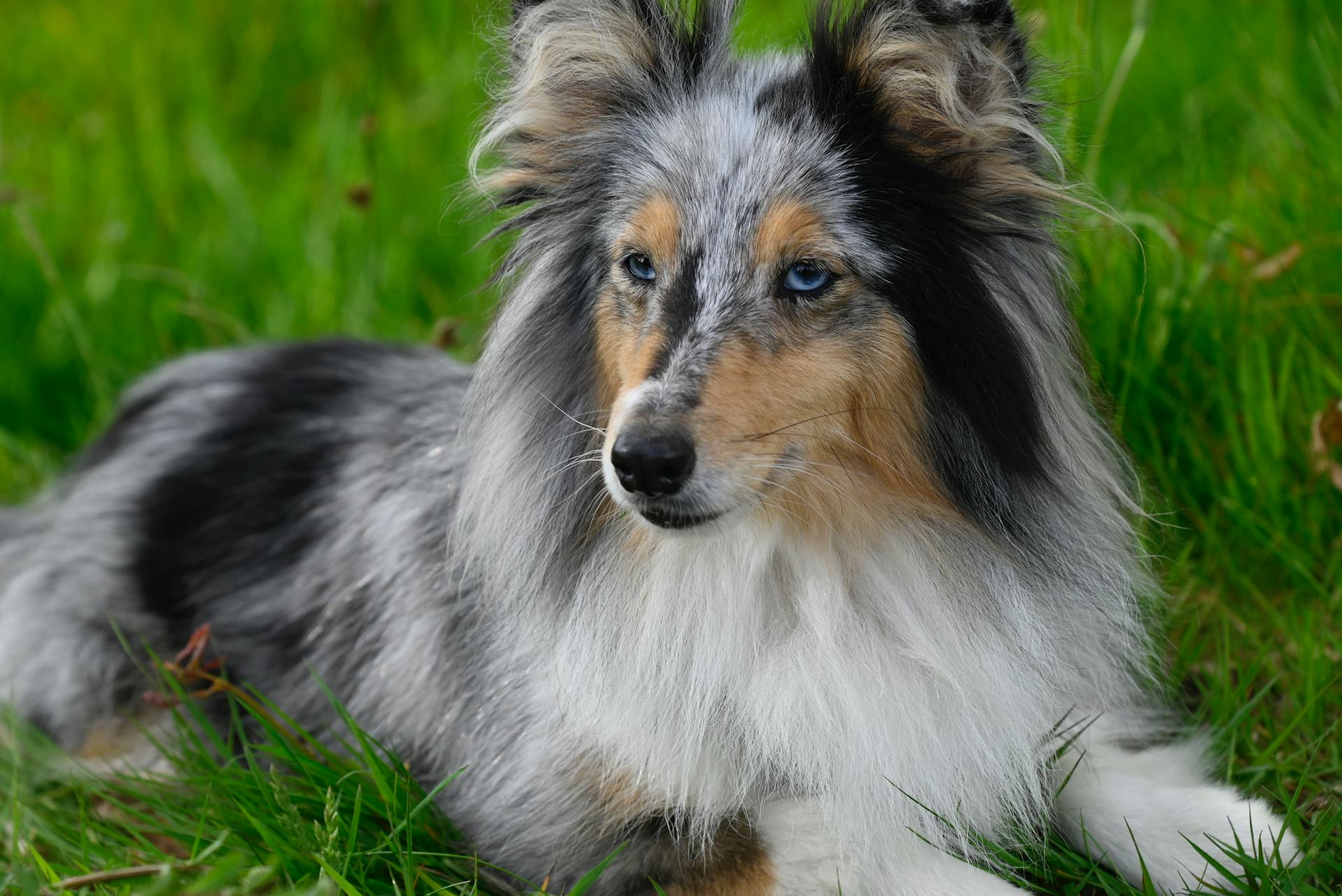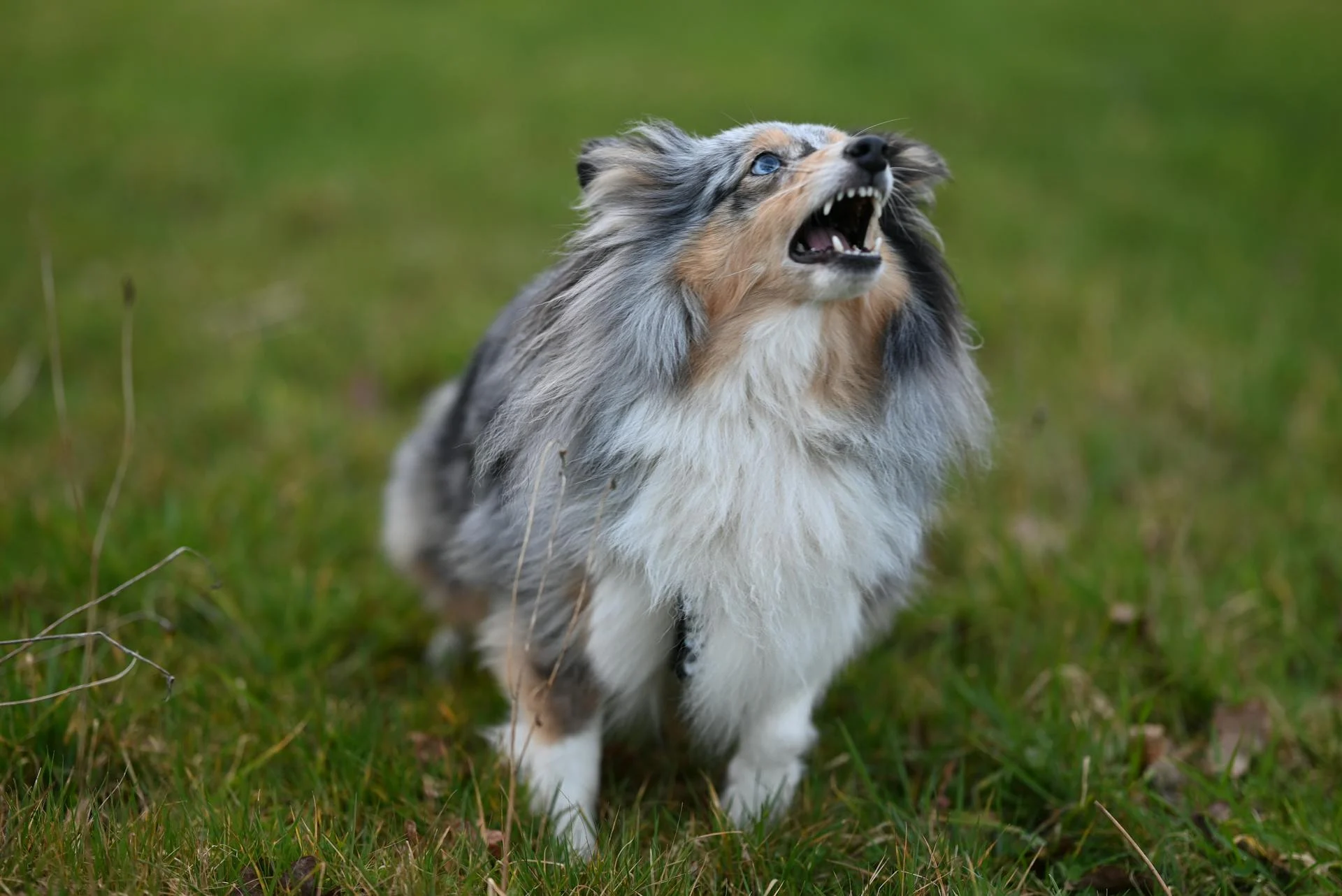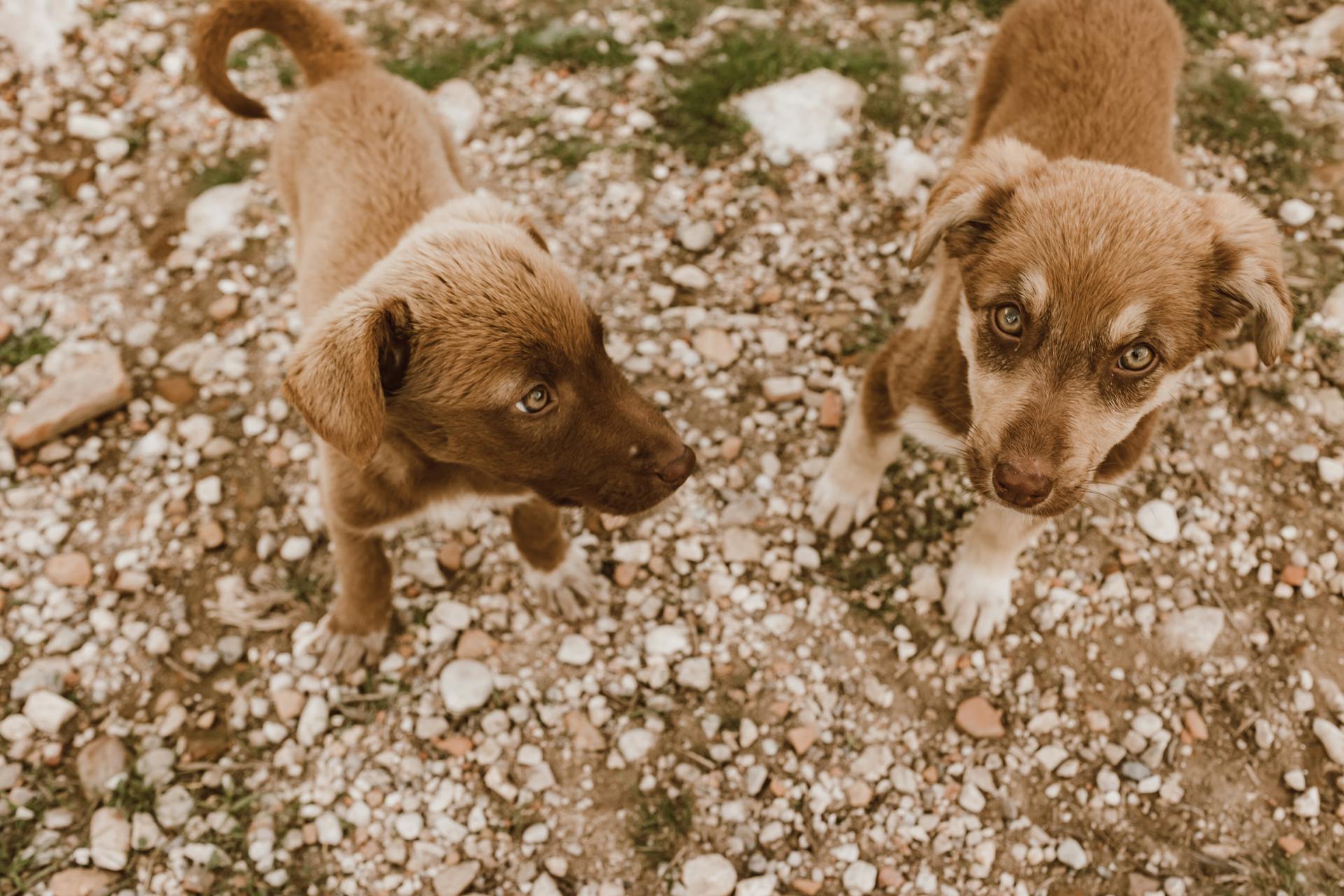
Welcoming a Shetland Sheepdog puppy into your family is a thrilling experience, but it requires careful preparation and attention to detail.
Shetland Sheepdogs are intelligent and active dogs that thrive on regular exercise and mental stimulation.
To ensure your puppy gets enough physical activity, aim for at least 30 minutes of playtime and training sessions per day.
Establishing a routine from an early age helps your puppy feel secure and develop good habits that will last a lifetime.
Breed Information
Shetland Sheepdogs are highly intelligent dogs, ranking sixth in intelligence among 132 breeds studied by Dr. Stanley Coren. They can learn new commands in under five repetitions and obey the first time given at least 95% of the time.
With their strong herding instinct, Shelties will enthusiastically chase and try to "herd" squirrels, rabbits, and children, running around them, barking, and nipping. This behavior can be discouraged by providing a fenced yard and plenty of mental stimulation.
Shelties are generally good with children, making them a popular choice for families. They are known for their loyalty and affection towards their families, often forming close bonds with their owners.
Expand your knowledge: Are Border Collies Good for First Time Owners
Overview
The Shetland Sheepdog is a small, active dog that originated in Scotland, specifically the Shetland Islands. They typically weigh between 14-27 pounds and have a lifespan of 12-14 years.
Their intelligence is one of their most notable characteristics, ranking sixth in intelligence among 132 different dog breeds. Shelties are quick learners and can understand a new command after being told it fewer than five times.
Shetland Sheepdogs are loving companions for all members of the family, including kids, but they can be reserved or even shy around strangers. This protective nature makes them excellent watchdogs, but they need training to prevent their barking from becoming a nuisance.
Here are some key characteristics of the Shetland Sheepdog breed:
Shelties are naturally inclined to herd, which can manifest in their behavior, such as nipping at heels. This instinct can be a challenge to manage, especially with children, but it's essential to discourage this behavior to prevent biting.
You might enjoy: Alaskan Malamute Behaviour
History
The Shetland Sheepdog, or Sheltie, has a rich and fascinating history. This breed was not developed by simply breeding the Rough Collie down to a smaller size, unlike many other miniature breeds.
The original sheepdog of Shetland was a Spitz-type dog, probably similar to the modern Icelandic Sheepdog. The breed's early history is shrouded in mystery, but it's believed to have been influenced by the Yakki, an Icelandic dog that accompanied whalers from Greenland.
Many of the early Shetlands were black and white or black and tan, and this coloring can still be seen in some sable dogs today. The breed's "smutty muzzles" are a nod to its Spitz-type ancestry.
The first club for the breed called for a dog similar to the Rough Collie, but smaller in size. This led to breeders adding collie blood to achieve the desired type.
The Kennel Club originally refused to recognize the breed, but later agreed to do so on the condition that the name was changed from Shetland Collie. This was due to opposition from collie breed clubs.
The original Spitz-type working sheepdog of Shetland is now extinct, having been replaced by the Border Collie.
Recommended read: 100 Years Ago Original Boston Terrier
Breed Organizations
If you're looking for a reputable breeder, there are organizations that can help you find one.
Reputable breeders are committed to breeding healthy, well-socialized puppies that will make great companions.
You can start by checking out breed organizations like the American Shetland Sheepdog Association.
Backyard breeders, on the other hand, are more interested in making a profit than in producing healthy, well-adjusted dogs.
Here are some key differences between reputable breeders and backyard breeders:
- Reputable breeders screen their breeding stock for health problems.
- Reputable breeders socialize their puppies from a young age.
- Backyard breeders may not screen their breeding stock for health problems.
- Backyard breeders may not socialize their puppies properly.
Health and Care
Shetland Sheepdogs are prone to certain health issues, so it's essential to be aware of them. They have a higher risk of developing transitional cell carcinoma, a cancer of the bladder, and hip dysplasia, with only 4.2% of Shetlands having the condition.
Their small size can make them more susceptible to bloat, so it's crucial to monitor their eating habits and prevent overeating. Regular exercise, such as walks and playtime, is also vital to maintain their physical and mental health.
Shetland Sheepdogs need regular dental care to prevent tartar buildup and periodontal disease, so brushing their teeth at least two or three times a week is a must.
Health

Shelties are generally a healthy breed, but they can be prone to certain health issues. The Sheltie's long, straight coat requires regular grooming to prevent matting and tangling.
Their compact size can sometimes make them more susceptible to hypoglycemia, a condition where their blood sugar levels drop too low. Shelties should be fed a balanced diet and given regular meals to prevent this.
Shelties are also known to be sensitive and loving towards their family members, but this sensitivity can sometimes make them more prone to anxiety and stress. Regular exercise and mental stimulation can help alleviate these issues.
A Sheltie's wedge-shaped head and erect ears make them a distinct breed, but these features also require some special care. Regular cleaning of their ears and eyes can help prevent infections.
Shelties typically live between 12 to 14 years, but with proper care and attention, some have been known to live longer. Regular veterinary check-ups and a healthy lifestyle can help ensure your Sheltie lives a long and happy life.
You might like: Sheltie vs Rough Collie
Health

Shetland Sheepdogs are generally healthy dogs, but they can be prone to certain inherited conditions.
They have a predisposition to several dermatological conditions, including allergic skin disease, cutaneous drug eruptions, and cutaneous or systemic lupus.
A North American study found that Shetlands have one of the lowest prevalence of hip dysplasia among breeds, with only 4.2% of Shetlands affected.
However, they are four times more likely to develop transitional cell carcinoma, a cancer of the bladder, compared to other breeds.
Von Willebrand disease is an inherited bleeding disorder that affects both type I and type III, making it essential to monitor their health closely.
Collie eye anomaly is an autosomal recessive inherited trait that can cause incomplete closure of the embryonic fissure, which is a common issue in Shetlands.
A mutation in the MDR1 gene causes sensitivity to certain drugs, including ivermectin, which can lead to adverse reactions.
Ulcerative dermatosis of Shetland sheepdog and rough collie (UDSSC) is a disease that affects the thigh, groin, axillae, and ventral abdomen, and is believed to be a vesicular variant of discoid lupus erythematosus.
Shetlands are also 93.87 times more likely to acquire gall bladder mucocele than other breeds, making it crucial to monitor their health closely.
Feeding a Puppy
Feeding a Shetland Sheepdog puppy requires attention to their individual needs, just like people do.
Puppies need to eat more frequently than adult dogs, about three or four times daily.
A good rule of thumb is to follow the feeding guide on your food bag to ensure your Sheltie pup is receiving essential daily nutrients.
Divide the daily recommended portions into meals instead of serving it all at once.
You should be able to see a waist on your Sheltie pup when looking down at them, and feel but not see their ribs without having to press hard.
Talk to your veterinarian about your dog's food, as they can give recommendations on portions based on your dog's weight, lifestyle, and health history.
For a Sheltie involved in sporting activities, you can consider supplementing with glucosamine and chondroitin to help keep their joints healthy.
Always consult with your veterinarian before giving your dog any supplements.
For your interest: Puppys Food
Pet Care Considerations
Shelties are a social breed that thrive on interaction with their family, so they should live indoors with their people as part of the family.
Their small size makes them suitable for apartment living, but they still need daily walks and playtime to stay happy and healthy.
To prevent barking, acknowledge your Sheltie's alert and give a verbal reprimand only if they continue barking.
Positive reinforcement training methods such as praise, play, and food rewards work best for Shelties, who can become bored easily if training is repetitive.
Daily dental hygiene is crucial to keep your Sheltie's breath fresh and prevent tartar buildup and periodontal disease.
Shelties are wary of strangers and may bark to alert their family or out of excitement, so socialization is key.
Their heavy coat requires frequent brushing to prevent matting and tangling.
Providing ample physical and mental stimulation is essential to prevent unwanted behaviors in Shelties, who are working dogs at heart.
You can supplement your Sheltie's diet with glucosamine and chondroitin for joint health, and omega-3 supplements to keep their skin and coat healthy.
Here's an interesting read: Shetland Sheepdog vs Sheltie
Grooming and Maintenance
Shelties have a beautiful double coat that requires regular brushing to prevent matting and tangling. You'll need to brush your Sheltie at least twice a week, and more often during shedding season.
The undercoat is short and dense, while the topcoat is longer and harsher, so be sure to get right down to the skin when brushing. Use a pin brush and a spray bottle to mist the coat as you go, and pay special attention to the fine hair behind the ears.
Males and spayed females generally shed once a year, while unspayed females shed twice a year, so be prepared for extra brushing during those times. You can also use a small slicker brush to gently tease out any mats that form in the fine hair behind the ears.
Here are some tips for grooming your Sheltie:
- Brush your Sheltie at least twice a week, and more often during shedding season.
- Use a pin brush and a spray bottle to mist the coat as you go.
- Pay special attention to the fine hair behind the ears.
- Trim nails once or twice a month to keep them short and neatly trimmed.
Bathing is only needed occasionally, and it's best to have a professional groomer trim out mats that form behind ears or under legs. Regular grooming will help keep your Sheltie's coat looking its best and prevent matting and tangling.
On a similar theme: Best Food for Border Collies
Coat and Colours
The Shetland Sheepdog's coat is truly one of its most striking features. A double coat, consisting of a harsh outer layer and a soft undercoat, sheds dirt and repels water, making it relatively low-maintenance.
The undercoat is short and dense, causing the longer, harsher topcoat to stand out from the body. This unique coat structure is essential for the breed's overall appearance.
Shelties come in three basic colors: sable, black, and blue merle. Sable coats range from golden to mahogany, while black coats are, well, black. Blue merle coats are a beautiful blue-gray with black markings.
Here's a breakdown of the acceptable colors:
- Sable: golden to mahogany
- Black
- Blue Merle: blue-gray with black markings
It's worth noting that white markings are allowed on most coat colors, except for black and tan. However, patches on the body are undesirable.
Regular grooming is essential to maintain the Shetland Sheepdog's beautiful coat. A thorough weekly brushing with a pin brush will help prevent matting and tangling, especially in the fine hair behind the ears.
Coat Grooming and Maintenance
Shelties have a beautiful double coat that requires regular grooming. A thorough weekly brushing with a pin brush is a must, getting right down to the skin to prevent matting and tangling.
You should brush your Sheltie's fine hair behind the ears frequently, as it tends to tangle easily. A small slicker brush can usually brush out any mats that form in this area.
Brushing your Sheltie regularly also helps to collect loose hair, which can be a lot during shedding season. Males and spayed females shed once a year, while unspayed females shed twice a year, a couple of months after each estrus period.
To keep your Sheltie's coat in top condition, you should bathe them only when they get really dirty. Trimming nails once or twice a month is also essential to keep their feet in good condition and prevent scratching.
Here's a quick guide to help you keep track of your Sheltie's grooming schedule:
Remember, grooming is an essential part of your Sheltie's overall health and well-being. By following this schedule and making grooming a positive experience, you'll help keep your Sheltie happy and healthy.
Ear Care
Ear cleaning is an essential part of Sheltie grooming. Routine ear cleaning with a veterinary-approved ear cleanser will help maintain your Sheltie’s healthy ear canals.
Frequently Asked Questions
What is the average price of a Sheltie puppy?
The average price of a Sheltie puppy ranges from $800 to $2,500, depending on the region. Prices vary by state, with the lowest costs found in the Midwest and highest in the Southeast.
Are shetland sheepdogs good pets?
Yes, Shetland Sheepdogs (Shelties) make excellent family pets due to their affectionate and sensitive nature. They are also intelligent and trainable, making them a great choice for active owners who want a loyal companion.
What are the negatives of a Sheltie?
Shelties are prone to health issues such as obesity, joint problems, and heart diseases if not properly exercised and fed. They can also be born with patent ductus arteriosus, a heart condition that requires veterinary attention.
Do shetland sheepdogs bark a lot?
Yes, Shetland Sheepdogs are known to be vocal and bark frequently. Their protective nature makes them good watchdogs, but also means they can be quite loud.
Can Shelties be black?
Yes, Shetland Sheepdogs can be black, but they must not have any rustiness in their coat. Black Shelties are one of the standard colors recognized by the breed standard.
Sources
- https://www.akc.org/dog-breeds/shetland-sheepdog/
- https://en.wikipedia.org/wiki/Shetland_Sheepdog
- https://rinhunter2020.medium.com/life-lessons-taught-by-a-sheltie-what-raising-a-sheltie-is-teaching-me-about-life-d41037de5c8c
- https://dogtime.com/dog-breeds/shetland-sheepdog
- https://www.petmd.com/dog/breeds/shetland-sheepdog
Featured Images: pexels.com


